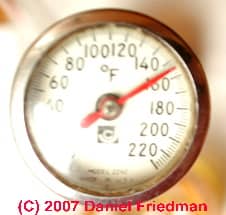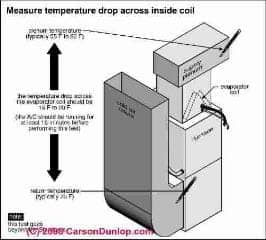 A/C Air Temperature MeasurementProcedures
A/C Air Temperature MeasurementProcedures
How to
Make Air Conditioning System Temperature Measurements
- POST a QUESTION or COMMENT about the steps or procedures to measure air conditioner or heat pump system temperatures
This article describes air conditioning temperatures and for measuring the air temperatures in an HVACV system we discuss thermometers, digital thermometers, infra red thermometers, temperature measuring equipment, temperature measuring devices, dial thermometers, sling psychrometers.
How & where to measure temperatures for air conditioners or heat pumps: this article explains exactly how and where to measure input and output air temperatures at air conditioning equipment in order to determine whether or not it is operating properly, as part of checking basic air conditioning system operation and for detection of air conditioning operating defects.
InspectAPedia tolerates no conflicts of interest. We have no relationship with advertisers, products, or services discussed at this website.
- Daniel Friedman, Publisher/Editor/Author - See WHO ARE WE?
Procedures for Making Temperature Measurements of Air Conditioning Systems
Air conditioner temperatures that are too high or too low can indicate specific operating problems on central and portable or window air conditioners. Simple measurements of air temperatures, if made at the right place, can assist in diagnosing what may be wrong and what repairs may be needed for the air conditioner.
This document is a portion of our website which describes the inspection of residential air conditioning systems (A/C systems) to inform home buyers, owners, and home inspectors of common cooling system defects.
Refrigeration and Air Conditioning Theory:
Refrigeration systems rely on two state changes of the refrigerant: gas to liquid, and liquid back to a gas to move sensible heat from the low side of the air conditioning system to the high side. At the evaporator coil heat (BTUs) is absorbed when the refrigerant evaporates (liquid to gas), and at the condenser coil heat is released during condensation (gas to liquid). R12 refrigerant has a boiling point of -21 degF (change of state from liquid to gas vapor) and R22 has a boiling point of -41 degF.
But if you are measuring air temperature close to the evaporator coil or condenser coil you won't record these two temperatures on your thermometer. Rather the temperature that you can record will be significantly affected by ambient conditions.
For example, at the evaporator coil the temperature of indoor air entering the coil, the distance between the coil surface and the thermometer, the air velocity, and other factors will produce a temperature reading that is different from and certainly higher than the boiling point of the refrigerant entering the coil.
While we may form an opinion about just how cool the air should be right at an evaporator coil, or inside of an air handler supply plenum, most diagnostics look for temperature differences between air entering the air handler and air leaving the air handler to evaluate what's going on in the system.
NOTE: an air conditioning technician has more precise tools to evaluate the condition of a system such as gauges to measure the pressures on the high side and low side of the system and an ammeter to measure current draw of the compressor.
How to Examine Air Conditioner Temperatures
Temperature Measurements & Observations at the Room Thermostat
Air conditioner thermostat settings:
observe the settings on the wall-mounted room thermostat (assuming you've already
established that the switches and controls have turned the system on and that it is in cooling mode and has
been operating for half an hour or longer.
Note the set-temperature (the cooling target set on the thermostat) and note the ambient
temperature (the actual air temperature close to the thermostat).
Most thermostats will tell you both the set temperature and the actual room temperature. These should be within 2-3 degrees F. of one another if the system has been in operation for several hours and if the air conditioning system is working properly and has adequate capacity and of course if you're using it normally with the building windows and doors closed, supply and return registers open, filters not clogged, etc.
Temperature Measurements at the Evaporator Coil in the Air Handler

How to Measure Air Conditioning Register outlet temperatures using a dial thermometer probe:
we simply wedge the probe of our dial thermometer between the vanes of a ceiling supply register, or drop it probe-first through the slots of a cool-air supply floor register where we leave it for at least five minutes. Sketch courtesy of Carson Dunlop Associates, a Toronto home inspection, education & report writing tool company [ carsondunlop.com ].
[Click to enlarge any image]
We select a supply air register closest to the air conditioning equipment if
at all possible, and if there is access we confirm visually that the duct is not crimped, blocked, and by simple
feel, we confirm that air is flowing out of it.
We use tissue or toilet paper to confirm for skeptical owners that the direction of air flow is "in" at a return register and "out" at a supply register since sometimes this can be confusing to a novice.
Measuring Air Conditioning Duct temperatures using a dial thermometer probe:
if there is not an existing duct opening such as a foil-covered hole or a removable plug, we drill a 1/4" diameter hole in the sheet metal of the duct. BE CAREFUL not to drill where you can damage a refrigerant line, coil, wire, etc.
After inserting the probe into the hole for measurement, waiting, taking our measurement, we close the hole using a square of adhesive foil tape, duct tape, or snap-in plugs sold for that purpose.
Temperature Measurements at the Condensing Coil & Fan/Compressor Unit
Measuring temperatures at an Air Conditioning Compressor:
By holding the thermometer's probe in any air path (and patience) it is trivial to measure ambient air temperature, air temperature flowing into the condenser unit at the condensing coils, and temperature flowing out of the condenser at its fan output (keep the probe out of the blades!)
Measuring Air Conditioning Temperatures Using an Infrared Thermometer
: permits measurement of
surface temperatures such as the surface of a metal duct (is it insulated?), surfaces of
refrigerant suction and high pressure lines (do we know target temperatures?), or surfaces inside
a building.
We use infrared temperature scanning of building surfaces to scan for currently wet conditions
(this won't tell you if there was previously a leak that has since dried, leaving behind a mold problem),
and to scan a building for air infiltration or ex filtration losses, and to scan for the presence or absence
of insulation (there must be a good difference, perhaps 20 degrees F, between indoor and outdoor temperatures
to make this check accurately) but we do not use infrared scanning on air conditioning equipment except to
look at the surface temperature of a heretically sealed compressor or to check for hot electrical connections
in the panel or switch box.
Remember that when using an infra-red sensor you may not be reading actual
surface temperature unless you're measuring a black surface. Some scanners are provided with a black
crayon or marker to make a spot to be used for temperature sensing. These devices are excellent, however,
for comparing the temperatures of different surfaces.
If your air conditioning or heat pump system has lost its cooling capacity or won't start
see REPAIR GUIDE for AIR CONDITIONERS.
See COOLING CAPACITY, RATED of air conditioning equipment if the system seems to be working but is inadequate to cool your building. Contact us to suggest text changes and additions and, if you wish, to receive online listing and credit for that contribution.
...
Continue reading at HVAC TEMPERATURE INSTRUMENTS or select a topic from the closely-related articles below, or see the complete ARTICLE INDEX.
Or see AIR CONDITIONER TEMPERATURE FAQs for diagnostic questions & answers regarding AC or heat pump temperatures
Or see these
Recommended Articles
- AIR CONDITIONER TEMPERATURES - air conditioner temperatures and some rules of thumb that are quick and easy to apply in diagnosing air conditioner problems
- AIR FLOW MEASUREMENT CFM in duct systems or HVAC systems
- GAUGE, REFRIGERATION PRESSURE TEST
- OPERATING TEMPERATURES HVAC if you need to know the normal operating temperatures of air conditioners & heat pumps and where those temperatures are measured
- HUMIDITY MEASUREMENT INSTRUMENTS and also HUMIDITY CONTROL & TARGETS INDOORS because the comfort level of indoor air is a function of both temperature and relative humidity
Suggested citation for this web page
AIR CONDITIONER TEMPERATURE MEASUREMENT at InspectApedia.com - online encyclopedia of building & environmental inspection, testing, diagnosis, repair, & problem prevention advice.
Or see this
INDEX to RELATED ARTICLES: ARTICLE INDEX to AIR CONDITIONING & HEAT PUMPS
Or use the SEARCH BOX found below to Ask a Question or Search InspectApedia
Ask a Question or Search InspectApedia
Try the search box just below, or if you prefer, post a question or comment in the Comments box below and we will respond promptly.
Search the InspectApedia website
Note: appearance of your Comment below may be delayed: if your comment contains an image, photograph, web link, or text that looks to the software as if it might be a web link, your posting will appear after it has been approved by a moderator. Apologies for the delay.
Only one image can be added per comment but you can post as many comments, and therefore images, as you like.
You will not receive a notification when a response to your question has been posted.
Please bookmark this page to make it easy for you to check back for our response.
IF above you see "Comment Form is loading comments..." then COMMENT BOX - countable.ca / bawkbox.com IS NOT WORKING.
In any case you are welcome to send an email directly to us at InspectApedia.com at editor@inspectApedia.com
We'll reply to you directly. Please help us help you by noting, in your email, the URL of the InspectApedia page where you wanted to comment.
Citations & References
In addition to any citations in the article above, a full list is available on request.
- Complete List of Air Conditioning & Heat Pump Design, Inspection, Repair Books at the InspectAPedia Bookstore.
- Modern Refrigeration and Air Conditioning, A. D. Althouse, C.H. Turnquist, A. Bracciano, Goodheart-Willcox Co., 1982
- Principles of Refrigeration, R. Warren Marsh, C. Thomas Olivo, Delmar Publishers, 1979
- Refrigeration and Air Conditioning Technology, 5th Ed., William C. Whitman, William M. Johnson, John Tomczyk, Cengage Learning, 2005, ISBN 1401837654, 9781401837655 1324 pages
- In addition to citations & references found in this article, see the research citations given at the end of the related articles found at our suggested
CONTINUE READING or RECOMMENDED ARTICLES.
- Carson, Dunlop & Associates Ltd., 120 Carlton Street Suite 407, Toronto ON M5A 4K2. Tel: (416) 964-9415 1-800-268-7070 Email: info@carsondunlop.com. Alan Carson is a past president of ASHI, the American Society of Home Inspectors.
Thanks to Alan Carson and Bob Dunlop, for permission for InspectAPedia to use text excerpts from The HOME REFERENCE BOOK - the Encyclopedia of Homes and to use illustrations from The ILLUSTRATED HOME .
Carson Dunlop Associates provides extensive home inspection education and report writing material. In gratitude we provide links to tsome Carson Dunlop Associates products and services.

